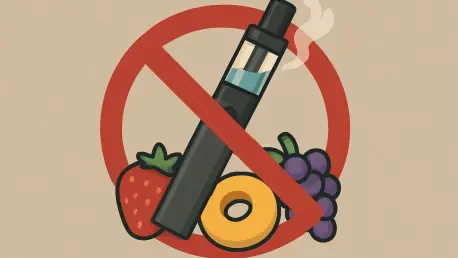In the rapidly evolving landscape of nicotine use and public health policies, Ivan Kairatov stands out as a leading expert in biopharma, specializing in tech and innovation within the industry. His extensive experience in research and development offers valuable insights into the effects of regulatory measures, such as e-cigarette flavor bans. Today, we dive into the findings from a recent study exploring the ramifications of these bans on smoking habits across various demographics.
Can you explain the main findings of your study on flavor bans and e-cigarette use?
Our study revealed that the implementation of flavor bans led to a noticeable decline in e-cigarette use among both young adults and older adults in states that adopted such policies. However, this decline in vaping appears to have been accompanied by a slower reduction in cigarette smoking rates in these same states. Interestingly, states without flavor bans did not show this pattern, suggesting an unintended consequence where reduced access to flavored e-cigarettes might lead some individuals back to smoking traditional cigarettes.
How did the introduction of flavor bans impact e-cigarette usage among different age groups?
The impact varied notably across age groups. For young adults, aged 18-24, e-cigarette use noticeably dropped by about 6.7 percentage points in states with bans compared to those without. Among adults over the age of 25, there was a smaller decline of about 1.2 percentage points. These statistics underscore a more pronounced effect of the bans on younger demographics, who tend to be more attracted to flavored tobacco products.
What were the specific changes observed in young adults aged 18-24?
This age group showed a significant reduction in vaping rates. Flavored e-cigarettes tend to appeal to younger users, so the removal of these offerings from the market likely had a substantial impact on this demographic. This indicates that flavor bans effectively discourage e-cigarette use among young adults, which aligns with the public health objective of reducing nicotine dependency in younger populations.
How did e-cigarette use change among adults over 25?
For adults over 25, the decline in e-cigarette use was less dramatic but still significant. A drop of 1.2 percentage points may not seem large, but it’s important because this age group typically shows more established patterns of nicotine use. The flavor bans appear to have curbed some enthusiasm for e-cigarettes among these adults, albeit to a lesser degree than in younger individuals.
How did flavor bans affect cigarette smoking rates in states that implemented them?
Surprisingly, in states with flavor bans, we observed an uptick in cigarette smoking rates among young people. Specifically, there was a 1.8 percentage point increase in cigarette use among youths and a 3.7 percentage point increase among young adults compared to expectations. This suggests that without access to flavored e-cigarettes, some individuals might turn back to traditional cigarettes as an alternative source of nicotine.
Was cigarette use among adults affected similarly?
Yes, adults were also impacted, though the changes were less pronounced compared to younger individuals. There wasn’t the same level of increased smoking seen in youths and young adults, but the trend of cigarette smoking declining more slowly relative to states without flavor bans was evident across all age groups.
Why might cigarette smoking decline less in states with flavor bans compared to those without?
One potential reason is that flavored products often serve as a bridge for smokers trying to quit or transition to less harmful forms of nicotine delivery. When these are removed from the market, individuals seeking the flavored experience might revert to smoking combustible cigarettes since they can’t find what they want among e-cigarettes.
Were there notable differences between states regarding the impacts of flavor bans?
Yes, the effectiveness of flavor bans varied significantly by state. Massachusetts, for instance, showcased a consistent decline in vape use across different age groups, possibly due to earlier local bans and stricter enforcement. On the other hand, states like Utah and Maryland that had certain exemptions saw less pronounced results, indicating the importance of comprehensive policy execution.
How did Massachusetts perform compared to other states with flavor bans?
Massachusetts stood out with a clear downward trend in e-cigarette usage across all age groups. This could be attributed to its strong regulatory environment and effective enforcement measures, setting it apart from states with more lenient policies or exemptions.
What exemptions did states like Utah and Maryland allow, and how did these affect the bans’ effectiveness?
These states allowed certain exemptions, such as the availability of menthol flavors or sales through specialty shops. These exemptions likely diluted the impact of the bans, as they provided loopholes that could be exploited by users seeking flavored options, thereby reducing the overall effectiveness of the policy.
What are some limitations of your study that might have impacted the findings?
One major limitation is the observational nature of the study, which doesn’t allow us to establish causality. There may be other unmeasured factors influencing tobacco use trends. Additionally, the data mainly reflects initial responses to flavor bans, and the long-term effects may differ as policies and market dynamics evolve.
How might the impact of flavor restrictions change over time in states with existing and new policies?
Over time, we might see different behavioral adaptations as people adjust to new regulations. It’s possible that initial increases in cigarette smoking could decline as more people adapt to other forms of nicotine replacement, or as enforcement becomes more stringent. Continuous monitoring is crucial to understanding these trends and making necessary policy adjustments.
What additional strategies do you suggest to curb youth nicotine use without slowing cigarette smoking decline?
A comprehensive approach could include stronger educational campaigns targeting youth, promoting nicotine cessation programs, and providing support to reduce reliance on tobacco products. Furthermore, ensuring that any changes in policy are accompanied by robust enforcement can help maximize the positive impacts of such bans.
How do these findings contribute to the ongoing debate about e-cigarette flavor bans and public health policy?
These findings highlight the complexity of implementing flavor bans. While they effectively reduce e-cigarette use among young people, they also present potential pitfalls in driving individuals towards traditional cigarettes. The study underscores the need for a balanced approach that tackles both vaping and smoking comprehensively, ensuring that policies do not inadvertently push one behavior in place of another.
Do you have any advice for our readers?
When considering the impacts of public health policies, it’s essential to view them holistically. Regulations like flavor bans have intricate effects that can extend beyond immediate goals. Being informed about these consequences helps advocate for more nuanced policies that can effectively address both ends of the nicotine use spectrum.









